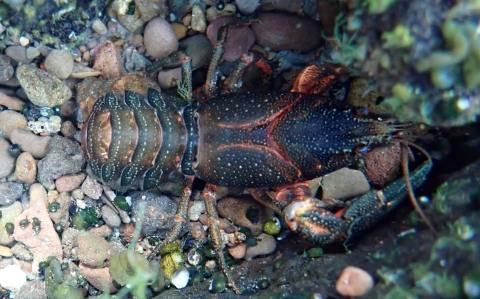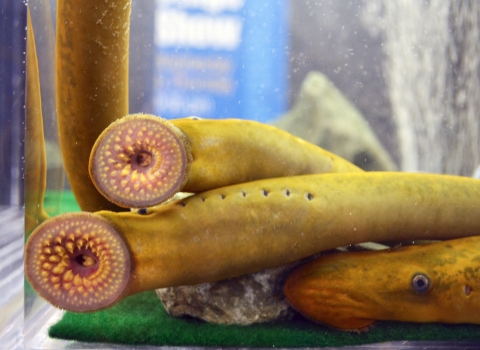The colors of the Shasta crayfish seem to pay tribute to the volcanic history of its home streams: a dark shell outlined in lava orange. The crayfish lives in the headwaters of the Modoc Plateau, an area formed 10 to 2 million years ago by ancient eruptions of lava and rock.
“We were snorkeling in dry suits because the water was so frigid, but it was also beautiful—so clear and blue,” said Chloe Hansum of the spring-fed stream where she and fellow Service biologist Lauren Kong were searching for the rare crustacean.
Hansum and Kong traveled hours from the Sacramento Fish and Wildlife Office to join local species experts Maria Ellis and Jeff Cook of Spring Rivers Ecological Sciences in the Fall River watershed, hoping for a glimpse of the rare species. It’s the last of California’s native crayfish, and its future has been compromised by the signal crayfish, a nonnative species from the Pacific Northwest.
“Shasta crayfish are a gentle species. You can have multiple generations living together under one rock. It’s unusual for crayfish to act that way,” said Kong, who is on her seventh year of studying crayfish. “Because they aren’t territorial or afraid of other crayfish, they easily lose habitat and become prey to the larger, more aggressive signal crayfish that has been introduced to their waters.”
The crew gently moved aside large rocks in the creek. After just fifteen minutes of searching, they found a Shasta crayfish.
“I was struck by the bright colors, the orange—there are barely words to describe the feeling of seeing one. It was magical,” said Hansum.
The stream where the Shasta crayfish was found has a metal barrier in the water to prevent new signal crayfish from traveling upstream. While signal crayfish were already in the exclusion area when the barrier was installed, regular surveys and signal crayfish removal keep their numbers and size there low.
“I’m hopeful for the future of this species because there’s really only one thing threatening them, and we know what it is: signal crayfish,” said Hansum. “The more we can get the word out on the harmful impacts of nonnative species to our native wildlife, the better the future will be for Shasta crayfish.”
The Service is taking part in efforts to establish new habitat in areas free of signal crayfish while supporting population control of the invasive species invasive species
An invasive species is any plant or animal that has spread or been introduced into a new area where they are, or could, cause harm to the environment, economy, or human, animal, or plant health. Their unwelcome presence can destroy ecosystems and cost millions of dollars.
Learn more about invasive species in current Shasta crayfish habitat. Aspects of the Shasta crayfish’s life history remains unknown, so the Service is working with partners to study the species’ needs in captivity in order to support future captive breeding projects.
“We’re thinking about the future and planning our next steps with our partners at Spring Rivers Ecological Sciences,” said Kong. “We’re hopeful that our efforts will save this unique and beautiful species from extinction.”




